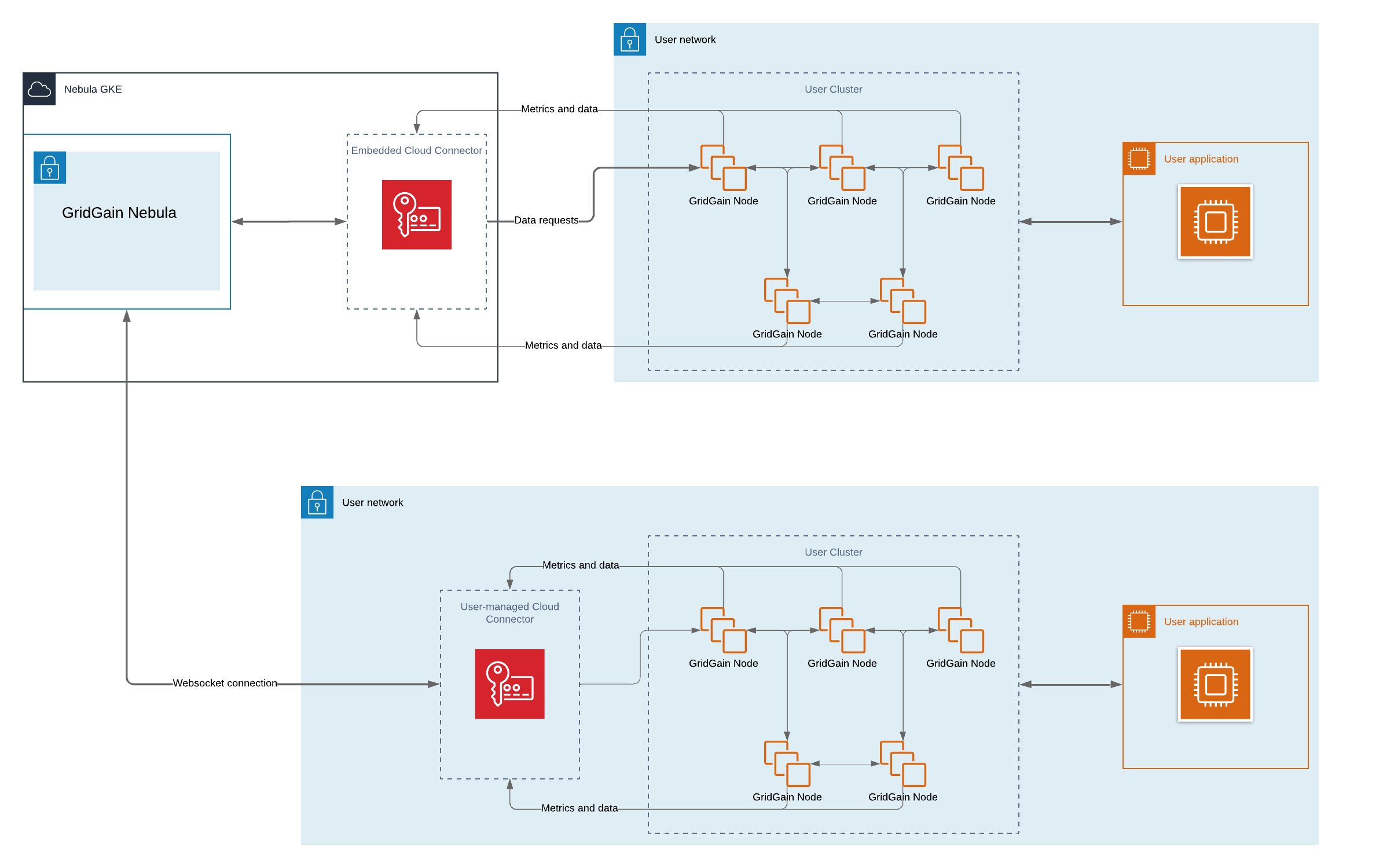Setting Up Cloud Connector with GridGain 9 and Nebula
Monitoring GridGain 9 clusters with Nebula typically requires exposing cluster ports to the internet, which can introduce security risks and complicate network configurations.
Cloud Connector resolves these issues by establishing a secure outbound connection from your network to Nebula, allowing clusters to remain within your private network while handling external communications securely.
The schema below displays the difference between connecting to GridGain 9 directly and by using Connector:

Download and Install Cloud Connector
To start using cloud connector, download it from the website and unpack the archive.
Configure Cloud Connector
Once you have unpacked the archive, you need to configure the Cloud Connector to work with your cluster. Open the application.properties file and update the following mandatory properties:
-
Set the
connector.cc-urlproperty to point to the Nebula portal URL (https://portal.gridgain.com/). -
Enter your Nebula account credentials in the
connector.usernameandconnector.passwordfields. -
Specify a unique
connector.nameto identify your connector in Nebula. -
Specify a base URL that will be use to establish connection between the cluster and the connector in the
connector.base-urlproperty. This URL must be accessible from the monitored cluster nodes to allow cluster exporters to send metrics to Nebula.
-
Here’s an example of what this part of the
application.propertiesfile could look like:connector.cc-url = https://portal.gridgain.com connector.name = My Cloud Connector connector.base-url = http://localhost:3200 connector.username = username connector.password = password
You can modify additional parameters such as SQL execution timeouts or monitoring intervals, or use their default values:
| Name | Description | Default value |
|---|---|---|
connector.cc-url |
Nebula Dashboard URL. |
|
connector.base-url |
Connector URL must be reachable from the monitored cluster nodes. |
|
connector.name |
Connector name. |
|
connector.username |
Your Nebula login. |
|
connector.password |
Your Nebula password. |
|
server.port |
Connector port. Must be accessible from the monitored cluster nodes. |
3200 |
connector.cluster.monitoring.heartbeat-max-retry-attemp |
Max failed heartbeat attempts before cluster considered disconnected. Set to |
0 |
connector.cluster.monitoring.heartbeat-interval |
The interval between the GG9 cluster heartbeats, in milliseconds. |
1000 |
connector.cluster.monitoring.timeout |
The monitoring cycle timeout, in milliseconds. |
20000 |
connector.cluster.monitoring.interval |
The interval between monitoring cycles, in milliseconds. |
20000 |
connector.sql.execute-timeout |
The timeout of SQL script execution, in hours. |
1 |
connector.sql.query-timeout |
The timeout of SQL query execution, in hours. |
1 |
connector.sql.fetch-timeout |
The timeout of cursor fetch execution, in minutes. |
10 |
connector.sql.cursor-timeout |
The cursor lifetime duration, in hours. If cursor in not fetched within this period, it is closed. |
1 |
Start Cloud Connector
Once the connector is configured, you have two options to run it: using the provided script or in a Docker container. Choose the approach that best fits your setup and deployment needs.
Running the connector using the script
Open the command line and run the connector script from the extracted folder.
./connector.shconnector.batRunning the Connector with Docker
If you prefer to use Docker, use the following steps.
-
Pull the latest Cloud Connector Docker image:
docker pull gridgain/cloud-connector:latest -
Set up a dedicated network for the connector and cluster:
docker network create cc -
Run the container with a previously configured
application.propertiesfile by using the following command:docker run -v /path/to/your/application.properties:/opt/cloud-connector/application.properties gridgain/cloud-connector:latest -
Alternatively, run the container by specifying the configuration parameters in environment variables directly. Set them as described in the connector configuration section.
docker run --network=cc --name=connector \ -e CONNECTOR_BASE_URL=http://connector:3200 \ -e CONNECTOR_USERNAME=email \ -e CONNECTOR_PASSWORD=password \ -e CONNECTOR_CC_URL=cc-url \ gridgain/cloud-connector:latest -
Start the GridGain cluster container within the same network. If your cluster is not yet running, refer to the GridGain 9 documentation on starting a node.
docker run --network=cc --name=ignite apacheignite/ignite:3.0.0docker run --network=cc --name=gridgain gridgain/gridgain9:latest -
When attaching the cluster to Nebula, use the following URL as the REST endpoint in the attach dialog:
http://ignite:10300http://gridgain:10300
Attach the Cluster to Nebula
To start using the connector with Nebula and your cluster, refer to the documentation on attaching a Gridgain 9 or Apache Ignite 3 cluster.
© 2025 GridGain Systems, Inc. All Rights Reserved. Privacy Policy | Legal Notices. GridGain® is a registered trademark of GridGain Systems, Inc.
Apache, Apache Ignite, the Apache feather and the Apache Ignite logo are either registered trademarks or trademarks of The Apache Software Foundation.
